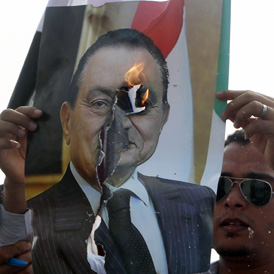Police give evidence as Egypt’s Mubarak returns to court
Egypt’s former President Hosni Mubarak has returned to court in Cairo for a third hearing in his trial on charges of corruption after the killing of protesters in the 18-day rebellion that ousted him.
The trial, which started on 3 August, has entered a new stage as the first witnesses, four policemen, give evidence against Hosni Mubarak.
Egypt’s state TV showed the ex-leader, who is in poor health, shielding his face from the sun as he was taken on a stretcher into the Cairo police academy, where the trial is being held.
In a move that has upset activists and relatives of those killed in the protests, the judge has stopped TV cameras from filming inside the courtroom.

There were fights as the victims’ families and protesters tried to get into the courtroom. Anti-riot police used their batons.
Metal barriers were also thrown, while officers chased men in the streets. The demonstrators held up posters depicting pictures of dead protesters and screamed “to die like them or to get their rights.”
Ramadan Ahmed Abdou, the father of one of the victims, said he applied for a permit to attend the court session and had been told he could pick up the pass the morning before the trial. But when he tried to pick it up he was told there was no permit for him.
Mubarak, 83, could be sentenced to death if convicted of killing protesters.
Around 850 protesters died in the rebellion that forced Mubarak from power in February, according to a government research committee.
Mubarak’s sons, who are also charged with corruption charges, are also due to appear in court.
Lawyers have put the wheels in motion for 1,000 witnesses to give evidence at the trial. These include Hussein Tantawi, the head of the council of generals that took charge of Egypt after Mubarak was deposed. Tantawi was formerly Mubarak’s defence minister.
